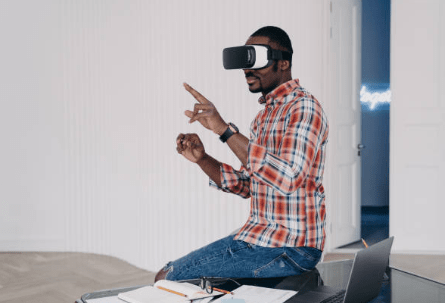
Virtual Reality (VR) stands out as a transformative technology that transcends the physical world’s limitations, leading us into immersive digital realms. In contrast to conventional computer interfaces, VR engrosses users in a three-dimensional, computer-generated environment, delivering a sensory-rich experience that can replicate or even surpass reality. This cutting-edge technology has fascinated the imaginations of enthusiasts and technophiles and has also permeated various industries, fundamentally altering how we learn, work, and seek entertainment. Engage with Managed IT Services Boston experts to leverage the power of virtual reality for your business.
In this article, we will explore what is virtual reality technology is, virtual reality examples and virtual reality applications.
What Does Virtual Reality Mean?
Virtual reality (VR) refers to a computer-generated simulation of an environment that can be experienced using a headset or other devices. This technology immerses the user in a virtual world, creating a sense of presence and allowing them to interact with their surroundings. Virtual reality aims to provide a realistic and immersive experience that can simulate real-world situations or create new ones.
Using specialized equipment and software, virtual reality can transport users to different places, enable them to explore virtual environments, and even interact with virtual objects or characters. Virtual reality has applications in various industries, including gaming, entertainment, education, healthcare, and more.
4 Examples of Virtual Reality For Business
- Training and Simulation
Virtual reality has proven to be an invaluable tool for training and simulation purposes. In indusion, healthcare, and the military, virtual reality allows individuals to experience realistic scenarios without the risks associated with real-world training. Pilots can practice emergency procedures in a virtual cockpit, surgeons can perform virtual surgeries to refine their skills, and soldiers can undergo simulated combat missions to enhance their tactical abilities.
By immersing users in a virtual environment, virtual reality enables them to gain practical experience and develop critical skills in a safe and controlled setting. This improves performance, reduces costs, and minimizes potential dangers that may arise from traditional training methods.
- Virtual Tourism
Virtual tourism is one of the many examples of virtual reality technology. With virtual tourism, individuals can explore and experience different destinations without being physically present. Through virtual reality headsets and immersive 360-degree videos, users can visit famous landmarks, museums, and even natural wonders from their homes.
This technology provides a unique and interactive way to travel and accessibility to those who may have physical limitations or financial constraints that prevent them from traveling in real life. Virtual tourism is revolutionizing who explores the world and is opening up new possibilities for experiencing different cultures and environments.
- Medical Applications
Virtual reality (VR) technology has numerous applications in the medical field. One example is the use of VR for surgical training and simulation. Surgeons can practice complex procedures in a virtual environment, allowing them to refine their skills and improve patient outcomes. VR has also been used in pain management, with patients being immersed in virtual worlds to distract from discomfort during procedures or chronic pain conditions.
Additionally, VR has shown promise in treating mental health disorders such as anxiety and post-traumatic stress disorder (PTSD), where exposure therapy can be conducted in a controlled and immersive environment. These examples highlight the diverse uses of VR in medicine, demonstrating its potential to revolutionize healthcare practices.
- Architectural Visualization
Architectural visualization is one of the many applications of virtual reality technology. It allows architects and designers to create immersive 3D models of buildings and spaces, giving clients and stakeholders a realistic preview of the final project in virtual reality; users can walk through virtual buildings, explore different design options, and get a true sense of scale and proportion.
This technology has revolutionized the architectural industry by providing a more interactive and engaging way to showcase designs, helping to improve communication between architects, clients, and other project stakeholders.
4 Applications of Virtual Reality in Business
- Healthcare
Virtual reality (VR) technology has numerous applications in the healthcare industry. It has proven to be a valuable tool for training and education, allowing students and healthcare professionals to practice procedures in a realistic and immersive environment. VR is also being used for pain management, particularly in the case of chronic pain or during medical procedures that can cause discomfort.
By providing patients with virtual environments that distract them from their pain or anxiety, VR can help reduce the need for medication and improve the overall patient experience. Additionally, VR therapy is being explored as a treatment for mental health conditions such as post-traumatic stress disorder (PTSD), phobias, and anxiety disorders. The immersive nature of VR allows therapists to create controlled environments where patients can gradually confront and overcome their fears or triggers.
- Engineering and Manufacturing
Virtual reality (VR) technology has numerous applications in engineering and manufacturing. By creating virtual environments that simulate real-world scenarios, engineers and manufacturers can visualize and test their designs before they are physically built. This is not only for time and resources but also for more efficient problem-solving and design optimization.
VR can also be used for training, allowing workers to practice complex tasks in a safe and controlled virtual environment. In addition, VR can enhance collaboration among team members by enabling them to work together remotely, regardless of their physical location.
- Simulations for Emergency Services
One of the applications of virtual reality that has proven particularly useful is simulations for emergency services. Virtual reality technology allows emergency responders, such as firefighters and paramedics, to train in realistic, immersive environments replicating real-life emergency situations.
These simulations can help emergency personnel practice their skills, improve decision-making, and enhance situational awareness in a controlled and safe environment. By providing a hands-on training experience, virtual reality can help prepare emergency responders for the challenges they may face in high-stress situations, ultimately leading to more effective and efficient emergency services.
- Gaming and Entertainment
Virtual reality has found numerous applications in the gaming and entertainment industry. With VR technology, gamers can immerse themselves in virtual worlds and have a more interactive and realistic gaming experience. This has revolutionized how games are played, allowing players to move and interact with their surroundings physically.
In addition to gaming, virtual reality is also used in the entertainment industry to create immersive experiences for movie-goers and music enthusiasts. VR headsets allow users to feel like they are part of the action, whether watching a movie or attending a live concert. The possibilities for virtual reality in gaming and entertainment are endless, and we can expect to see even more innovative uses of this technology in the future.
Conclusion
Virtual reality (VR) represents a transformative technology that has transitioned from a conceptual idea to a diverse and influential tool with many applications. From immersive gaming experiences to groundbreaking advancements in healthcare, education, and business, VR has demonstrated its versatility and potential to reshape how we engage with information and the world around us. As technology progresses, we can anticipate even more innovative applications and integration into our daily lives. Virtual reality not only provides captivating and enjoyable experiences but also holds the potential to enhance learning, collaboration, and problem-solving on a global scale. For more information, visit IT Support Cambridge experts.



